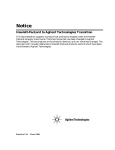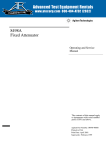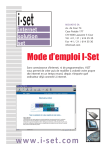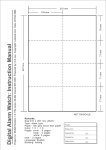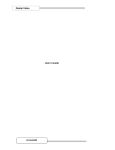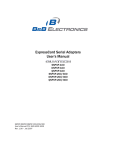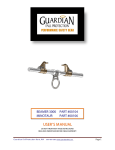Download PASCO Specialty & Mfg. TD-8577 User's Manual
Transcript
Instruction Manual 012-13028B PASCO Compression Igniter TD-8577 Knob Removable Top si Pis ton Starting Po Piston ti o n Outer Safety Tube (polycarbonate) Inner Glass Tube “O” rings “O” rings Bottom Removable Base Loading/Cleaning Rod Replacement Glass Tube Small O-ring (4) Medium O-ring (1) Replacement O-rings (6) ® Large O-ring (1) IMPORTANT! Piston Starting Position label PASCO Compression Igniter 012-13028B Included Equipment Included Equipment PASCO Compression Igniter Replacement Glass Tube* Loading/Cleaning Rod Replacement O-rings* (6) Introducti on Lubricant, silicone compound, (2 packets), not shown Material Safety Data Sheet for Lubricant Additional Item Needed Cotton, tissue paper, “flash paper” * The TD-8498A Replaceable Glass Tubes includes two replacement tubes and twelve O-rings. Introduction The TD-8577 PASCO Compression Igniter (or “fire syringe”) illustrates what happens inside the cylinder of a diesel engine. It demonstrates the high temperatures produced during adiabatic compression of air by igniting a small amount of cotton, tissue paper, or magician’s “flash paper” inside a replaceable, thick-wall glass tube. The glass tube is encased in a polycarbonate safety tube that protects users from injury if the glass tube breaks. The piston has two rubber “O” rings at its end that provide a tight seal against the inside of the glass tube. When the piston is rapidly pressed down into the glass tube, the temperature inside the tube rises quickly. The Compression Igniter comes with one replacement glass tube and six O-rings. The large O-ring is a replacement for the ring at the top of the inner glass tube. The medium O-ring is a replacement for the ring at the top of the piston rod where it joins the knob. The small O-rings are replacements for the rings on the end of the piston rod and for the rings on the post that is part of the removable base. Theory The compression of air inside a hollow cylinder is an adiabatic process since the compression is so fast that there is no time for thermal energy to leave or enter the cylinder. For an adiabatic compression of gas, PV = constant , where P is the pressure of the gas, V is the volume of the gas, and is the ratio of specific heats of the gas (specific heat at constant pressure divided by specific heat at constant volume) Therefore, when the gas in the cylinder is at its original volume V0 and pressure P0 and then is compressed to a small volume V and pressure P, PV = P 0 V 0 With the compression igniter, it is possible to compress the gas in the cylinder by a factor of about 15, so V0 = 15V. With this assumption, the final pressure at maximum compression can be calculated in terms of the initial (atmospheric) pressure: PV = P 0 15V P = 15 P 0 The quantity that is of interest is the final temperature: Is it high enough to ignite paper? To arrive at the temperature, assume that the gas is air and that it is an ideal gas. For an ideal gas, P 0 V 0 = nRT 0 and The ignition temperature of paper is about 451 °F. See the science fiction novel Fahrenheit 451 by Ray Bradbury. PV = nRT 2 ® Model No.TD-8577 012-13028B Operation where n is the number of moles of gas, R is the gas constant, and T is the absolute (thermodynamic) temperature. Solving the initial equation for nR and substituting the expression into the final equation gives: P0 V0 T PV = ---------------T0 Solving for the final temperature, T, and substituting the final pressure, P, derived from the adiabatic equation and the final volume, V, which is 1/15 the initial volume gives: 15 P 0 V PV T = ------------ T 0 = --------------------- T 0 P0 V0 P 0 15V Simplifying this expression gives T = 15( - 1)T0. For air, which is mainly diatomic, = 1.4, so this gives T = 150.4T0. Assuming that the initial temperature is about 24 °C (297 K), then T = 150.4(297 K) = 877 K. Converting to celsius, T = 604 °C. Since 604 °C = 1120 °F, the temperature is high enough to ignite paper. Operation 1. Turn the removable base counterclockwise to unscrew it from the bottom of the igniter. Remove the base and set it aside. 2. Insert a small piece (~ 1 cm2) of tissue paper or a few strands of cotton fiber (e.g., pulled from the end of a cotton swab) into the bottom of the glass tube. Push knob down rapidly Piston Top Safety Tube Bottom Glass Tube Removable Base Insert combustible material here. Piston Starting Position label 3. Use the loading/cleaning rod to push the material up into the lower part of the glass tube. Carefully remove the loading/cleaning rod without pulling the material out of the lower part of the glass tube. 4. tube IMPORTANT: Insert the piston into the top of the igniter and push it in far firmly enough that the end of the piston lines up with or is slightly below the “Piston Starting Position” label on the outer tube 2.5 cm (1 inch) below the top. 5. Replace the removable base by screwing it clockwise into the bottom. 6. Place the base of the igniter on a sturdy horizontal surface and securely hold the material tube with one hand. Make sure that the combustible material in the bottom of the glass tube is visible. Watch 7. Watch the piece of combustible material at the bottom of the glass cylinder. 8. With the palm of your other hand, quickly slap down on the knob of the piston so the end of the piston goes down into the cylinder rapidly. i sit Pis ton Starting Po o n Grip Combustible here ® 3 PASCO Compression Igniter 012-13028B Caution . • Do not ‘clump’ or compress the combustible material. Allow it to remain flat and spread out. The more surface area it has, the better. • If the material does not ignite, try reducing the amount of material you put into the glass tube. • If you are using a piece of tissue paper, remove the paper and tear it in half. Put one half of the paper back into the glass tube and try again. • If you are using cotton and it does not ignite, reduce the number of strands of cotton and try again. Maintenance Cleaning To remove fragments of burned material from the igniter, unscrew the removable base from the bottom of the igniter. Use the loading/cleaning rod to scrape any residue out of the lower part of the glass tube. To clean the glass tube, remove the piston and the base. Use the loading/cleaning rod to push a small wad of tissue paper through the glass tube. After cleaning, screw the removable base back into the bottom of the igniter. Do not use a wrench or other tool to tighten the removable base or the top. Instead, they should be only as tight as you can make them using your hand. Lubrication The “O” rings on the piston and the removable base are lubricated at the factory. If the “O” rings on the piston become dry, tear or cut the tip off the packet of lubricant. Squeeze a small drop (1 to 2 mm diameter) of lubricant onto an applicator (such as a toothpick, cotton-tipped swab, etc.), and rub the lubricant onto the two “O” rings. Store the open packet in a plastic bag or a small jar. CAUTION: Do not use a different lubricant than the kind provided. Loading/Cleaning Rod Storage Store the compression igniter with the piston removed from the inner glass tube. Glass Tube Caution The inner cylinder in the Compression Igniter is thick-wall glass, but it can break if the Compression Igniter is dropped or if the piston is not far enough down into the glass tube when the igniter is used. Before using the igniter, be sure that the bottom of the piston is at least to the “Piston Starting Position” label. Wad of tissue paper Be careful when handling the Compression Igniter, and always store the igniter with the piston removed from the glass tube. The Compression Igniter is shipped with a replacement inner glass tube packed separately to minimize the possibility of damage during transit. 4 ® Model No.TD-8577 012-13028B Caution Replacing the Inner Glass Tube If the glass tube in the Compression Igniter should break, replace it with the included replacement glass tube*. • Hold the igniter over a receptacle to catch any falling glass and remove the piston. • Unscrew the removable base from the bottom, and unscrew the top from the safety tube. • Carefully remove any broken glass from inside the safety tube and dispose of the glass properly. 1. Remove the top. 2. Clear the broken glass. Safety Tube Glass Tube • Check the condition of the O-rings and replace them if necessary. NOTE: If the O-rings show no abrasion damage, they do not need replacing. • Screw the removable base into the bottom of the igniter. Leave the top off the igniter. • Carefully insert the replacement glass tube into the igniter so that the bottom end of the glass tube fits over the post at the bottom of the igniter. • Replace the top on the igniter. Be careful to line up the upper end of the inner glass tube with the hole in the top. *The TD-8498A Replaceable Glass Tubes kit includes two more replacement tubes and twelve O-rings 3. Insert the replacement glass tube. Insert the glass tube over the post and O-rings. Post Top Base Replacing a Large O-ring Top • To replace the large O-ring in the top of the igniter, unscrew the top from the safety tube. • Remove the old O-ring. (You may need to use a small, flat-blade screwdriver to remove the ring.) 4. Replace the top. Pis ton Star tion ting Posi • Place the replacement O-ring in the groove at the bottom of the hole. Make sure that the O-ring is flat against the bottom of the hole.. Side View (cutaway) Top View O-ring Glass Tube O-ring installed Removable Top Replacing a Glass Tube Replacing a Large O-ring into the Top • Replace the top on the igniter. Line up the top end of the glass tube with the hole in the top and then turn the top clockwise to screw it onto the igniter. ® 5 PASCO Compression Igniter 012-13028B Technical Support For assistance with any PASCO product, contact PASCO at: Address: PASCO scientific 10101 Foothills Blvd. Roseville, CA 95747-7100 Phone: +1 916-786-3800 (worldwide) 800-772-8700 (U.S.) Web: www.pasco.com Email: [email protected] Technical Support Specifications Inside diameter of glass tube = 0.797 cm Compressible length of glass tube = 18.308 cm Compression ratio (approximate) = 15 to 1 For more information about the PASCO Compression Igniter and the latest revision of this Instruction Manual, visit the PASCO web site at www.pasco.com and enter TD-8577 in the Search window. Limited Warranty For a description of the product warranty, see the PASCO catalog. Copyright The PASCO scientific 012-13028B PASCO Compression Igniter Instruction Manual is copyrighted with all rights reserved. Permission is granted to non-profit educational institutions for reproduction of any part of this manual, providing the reproductions are used only in their laboratories and classrooms, and are not sold for profit. Reproduction under any other circumstances, without the written consent of PASCO scientific, is prohibited. Trademarks PASCO and PASCO scientific are trademarks or registered trademarks of PASCO scientific, in the United States and/or in other countries. For more information visit www.pasco.com/legal. Material Safety Data Sheet Please see the next four pages. 6 ® DOW CORNING CORPORATION Material Safety Data Sheet Page: 1 of 7 Version: 1.5 Revision Date: 2011/01/28 (989) 496-5900 (989) 496-6000 (989) 496-6315 (800) 424-9300 DOW CORNING(R) 111 VALVE LUBRICANT & SEALANT 1 Instability/Reactivity 0 Revision Date: 2011/01/28 24 Hour Emergency Telephone: Customer Service: Product Disposal Information: CHEMTREC: 0 Flammability Silicone grease. Grease Translucent white Odorless 1. PRODUCT AND COMPANY IDENTIFICATION Dow Corning Corporation South Saginaw Road Midland, Michigan 48686 MSDS No.: 01889834 Generic Description: Physical Form: Color: Odor: NFPA Profile: Health Note: NFPA = National Fire Protection Association 2. HAZARDS IDENTIFICATION POTENTIAL HEALTH EFFECTS DOW CORNING CORPORATION Material Safety Data Sheet Page: 2 of 7 Version: 1.5 Revision Date: 2011/01/28 DOW CORNING(R) 111 VALVE LUBRICANT & SEALANT The above listed potential effects of overexposure are based on actual data, results of studies performed upon similar compositions, component data and/or expert review of the product. Please refer to Section 11 for the detailed toxicology information. 3. COMPOSITION/INFORMATION ON INGREDIENTS None present. This is not a hazardous material as defined in the OSHA Hazard Communication Standard. Skin: Eye: If symptoms are experienced remove source of contamination or move victim to fresh air. If irritation persists, obtain medical advice. No health effects expected. If irritation does occur flush with lukewarm, gently flowing water for 5 minutes. If irritation persists, obtain medical advice. If irritation occurs, flush eye(s) with lukewarm gently flowing water for 5 minutes. Obtain medical attention. 4. FIRST AID MEASURES Inhalation: If irritation or discomfort occur, obtain medical advice. > 214 °F / > 101.1 °C (Closed Cup) 5. FIRE FIGHTING MEASURES Treat according to person's condition and specifics of exposure. Direct contact may cause temporary redness and discomfort. Flash Point: Not determined. Oral: Eye: No significant irritation expected from a single short-term exposure. Not determined. Notes to Physician: Skin: No significant effects expected from a single short-term exposure. Autoignition Temperature: Acute Effects Inhalation: Flammability Limits in Air: On large fires use dry chemical, foam or water spray. On small fires use carbon dioxide (CO2), dry chemical or water spray. Water can be used to cool fire exposed containers. Low ingestion hazard in normal use. Extinguishing Media: Self-contained breathing apparatus and protective clothing should be worn in fighting large fires involving chemicals. Determine the need to evacuate or isolate the area according to your local emergency plan. Use water spray to keep fire exposed containers cool. Prolonged/Repeated Exposure Effects No known applicable information. Fire Fighting Measures: None. 6. ACCIDENTAL RELEASE MEASURES Unusual Fire Hazards: Oral: Skin: No known applicable information. No known applicable information. Inhalation: Oral: No known applicable information. Signs and Symptoms of Overexposure No known applicable information. Medical Conditions Aggravated by Exposure 7 ® Material Safety Data Sheet 012-13028B Model No.TD-8577 DOW CORNING CORPORATION Material Safety Data Sheet Page: 3 of 7 Version: 1.5 Revision Date: 2011/01/28 DOW CORNING(R) 111 VALVE LUBRICANT & SEALANT Containment/Clean up: Observe all personal protection equipment recommendations described in Sections 5 and 8. Wipe up or scrape up and contain for salvage or disposal. Clean area as appropriate since spilled materials, even in small quantities, may present a slip hazard. Final cleaning may require use of steam, solvents or detergents. Dispose of saturated absorbant or cleaning materials appropriately, since spontaneous heating may occur. Local, state and federal laws and regulations may apply to releases and disposal of this material, as well as those materials and items employed in the cleanup of releases. You will need to determine which federal, state and local laws and regulations are applicable. Sections 13 and 15 of this MSDS provide information regarding certain federal and state requirements. Note: See Section 8 for Personal Protective Equipment for Spills. Call (989) 496-5900, if additional information is required. 7. HANDLING AND STORAGE Use with adequate ventilation. Avoid eye contact. Use reasonable care and store away from oxidizing materials. This material in its finely divided form presents an explosion hazard. Follow NFPA 654 (for chemical dusts) or 484 (for metal dusts) as appropriate for managing dust hazards to minimize secondary explosion potential. 8. EXPOSURE CONTROLS / PERSONAL PROTECTION There are no components with workplace exposure limits. Component Exposure Limits Engineering Controls None should be needed. Recommended. Suitable Gloves: Skin: Eyes: No respiratory protection should be needed. Handle in accordance with good industrial hygiene and safety practices. Washing at mealtime and end of shift is adequate. Use proper protection - safety glasses as a minimum. Personal Protective Equipment for Routine Handling Local Ventilation: General Ventilation: Inhalation: None should be needed. Personal Protective Equipment for Spills Suitable Respirator: DOW CORNING CORPORATION Material Safety Data Sheet Page: 4 of 7 Version: 1.5 Revision Date: 2011/01/28 DOW CORNING(R) 111 VALVE LUBRICANT & SEALANT Washing at mealtime and end of shift is adequate. No respiratory protection should be needed. Use proper protection - safety glasses as a minimum. Avoid eye contact. Use reasonable care. Eyes: Inhalation/Suitable Respirator: Skin: Precautionary Measures: Note: These precautions are for room temperature handling. Use at elevated temperature or aerosol/spray applications may require added precautions. Grease Translucent white Odorless 1.1 Not determined. Not determined. Not determined. Not determined. Not determined. Not determined. Not determined. Not determined. > 214 °F / > 101.1 °C (Closed Cup) Not determined. Not determined. 9. PHYSICAL AND CHEMICAL PROPERTIES Physical Form: Color: Odor: Specific Gravity @ 25°C: Viscosity: Freezing/Melting Point: Boiling Point: Vapor Pressure @ 25°C: Vapor Density: Solubility in Water: pH: Volatile Content: Flash Point: Autoignition Temperature: Flammability Limits in Air: Note: The above information is not intended for use in preparing product specifications. Contact Dow Corning before writing specifications. Chemical Stability: Oxidizing material can cause a reaction. Hazardous polymerization will not occur. Stable. 10. STABILITY AND REACTIVITY Hazardous Polymerization: Conditions to Avoid: None. Materials to Avoid: Hazardous Decomposition Products Thermal breakdown of this product during fire or very high heat conditions may evolve the following decomposition products: Carbon oxides and traces of incompletely burned carbon compounds. Silicon dioxide. Formaldehyde. ® 8 Material Safety Data Sheet 012-13028B PASCO Compression Igniter DOW CORNING CORPORATION Material Safety Data Sheet Page: 5 of 7 Version: 1.5 Revision Date: 2011/01/28 Low >100 >2000 DOW CORNING(R) 111 VALVE LUBRICANT & SEALANT 11. TOXICOLOGICAL INFORMATION Special Hazard Information on Components No known applicable information. 12. ECOLOGICAL INFORMATION Environmental Fate and Distribution Complete information is not yet available. Environmental Effects Complete information is not yet available. Fate and Effects in Waste Water Treatment Plants Complete information is not yet available. Ecotoxicity Classification Criteria High Medium <=1 >1 and <=100 <=100 >100 and <= 2000 This table is adapted from "Environmental Toxicology and Risk Assessment", ASTM STP 1179, p.34, 1993. Hazard Parameters (LC50 or EC50) Acute Aquatic Toxicity (mg/L) Acute Terrestrial Toxicity This table can be used to classify the ecotoxicity of this product when ecotoxicity data is listed above. Please read the other information presented in the section concerning the overall ecological safety of this material. DOW CORNING CORPORATION Material Safety Data Sheet Page: 6 of 7 Version: 1.5 Revision Date: 2011/01/28 DOW CORNING(R) 111 VALVE LUBRICANT & SEALANT Air Shipment (IATA) Not subject to IMDG code. Not subject to IATA regulations. Call Dow Corning Transportation, (989) 496-8577, if additional information is required. 15. REGULATORY INFORMATION All chemical substances in this material are included on or exempted from listing on the TSCA Inventory of Chemical Substances. Contents of this MSDS comply with the OSHA Hazard Communication Standard 29 CFR 1910.1200. TSCA Status: EPA SARA Title III Chemical Listings Section 302 Extremely Hazardous Substances (40 CFR 355): None. Section 304 CERCLA Hazardous Substances (40 CFR 302): None. Note: Chemicals are listed under the 313 Toxic Chemicals section only if they meet or exceed a reporting threshold. Section 313 Toxic Chemicals (40 CFR 372): None present or none present in regulated quantities. Section 311/312 Hazard Class (40 CFR 370): Acute: No Chronic: No Fire: No Pressure: No Reactive: No RCRA Hazard Class (40 CFR 261) Supplemental State Compliance Information 13. DISPOSAL CONSIDERATIONS When a decision is made to discard this material, as received, is it classified as a hazardous waste? No Massachusetts None known. Warning: This product contains the following chemical(s) listed by the State of California under the Safe Drinking Water and Toxic Enforcement Act of 1986 (Proposition 65) as being known to cause cancer, birth defects or other reproductive harm. California State or local laws may impose additional regulatory requirements regarding disposal. Call (989) 496-6315, if additional information is required. 14. TRANSPORT INFORMATION DOT Road Shipment Information (49 CFR 172.101) Ocean Shipment (IMDG) Not subject to DOT. 9 ® Material Safety Data Sheet 012-13028B Model No.TD-8577 DOW CORNING CORPORATION Material Safety Data Sheet Wt % 7.0 - 13.0 Wt % Polydimethylsiloxane Component Name Silica, amorphous Component Name New Jersey Page: 7 of 7 Version: 1.5 Revision Date: 2011/01/28 DOW CORNING(R) 111 VALVE LUBRICANT & SEALANT CAS Number 70.0 - 90.0 Dimethyl siloxane, hydroxy-terminated Silica, amorphous 7631-86-9 63148-62-9 5.0 - 10.0 7.0 - 13.0 CAS Number 7631-86-9 70.0 - 90.0 Dimethyl siloxane, hydroxy-terminated Silica, amorphous Polydimethylsiloxane Component Name 63148-62-9 5.0 - 10.0 7.0 - 13.0 Wt % 70131-67-8 Pennsylvania 7631-86-9 CAS Number 70131-67-8 16. OTHER INFORMATION Prepared by: Dow Corning Corporation (R) indicates Registered Trademark These data are offered in good faith as typical values and not as product specifications. No warranty, either expressed or implied, is hereby made. The recommended industrial hygiene and safe handling procedures are believed to be generally applicable. However, each user should review these recommendations in the specific context of the intended use and determine whether they are appropriate. 10 ® Material Safety Data Sheet 012-13028B Model No.TD-8577











